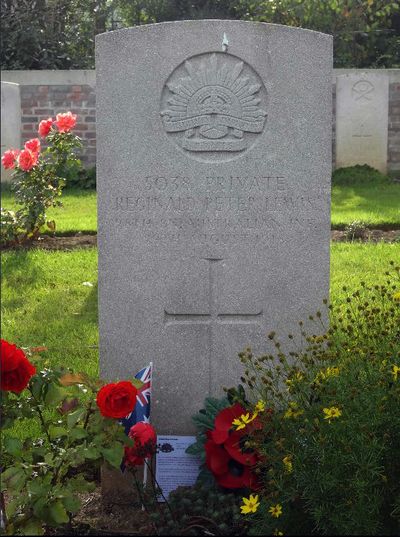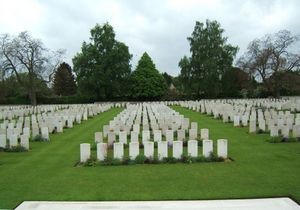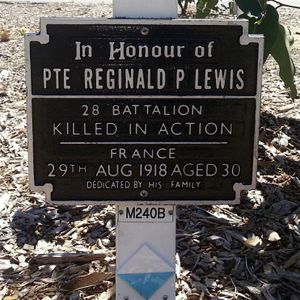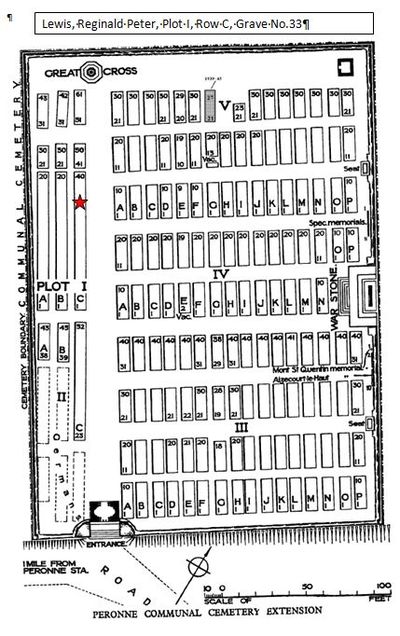Reginald Peter Lewis
From Our Contribution
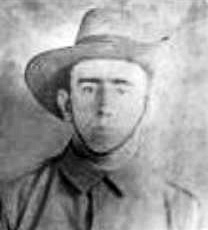 Courtesy Joy Dalgleish | |
|
Ancestry Haynes Family Tree | |
| Personal Information | |
|---|---|
| Date of Birth |
not known "not known" contains an extrinsic dash or other characters that are invalid for a date interpretation. |
| Place of Birth | Jarrahdale, Western Australia |
| Death | 29 Aug 1918 |
| Place of Death | Flaucourt, France |
| Age at Enlistment | 28 years old |
| Occupation | Mill hand |
| Religion | Methodist |
| Address | Jarrahdale, Western Australia |
| Next of Kin | Wife , Mrs Grace Myrtle Lewis |
| Military Information | |
| Reg Number | 5038 |
| Date of Enlistment | 20 Mar 1916 |
| Rank | Private |
| Unit/Formation | 28th Battalion, 13th Reinforcement / 7th Brigade, 2nd Division |
| Date of Embarkation | 18 Jul 1916 ‒ 9 Sep 1916 |
| Ship Embarked On | HMAT A48 Seang Bee |
| Fate | Killed in Action 29 Aug 1918 |
| Monument |
Jarrahdale War Memorial Jarrahdale Honour Roll ANZAC Memorial Park (Byford) Australian War Memorial |
| Medals |
British War Medal Victory Medal |
Contents
[hide]Pre War
Reg was born in Jarrahdale, Western Australia in February 1888 to Joseph and Marry Ann Lewis. He was the elder brother of Herbert and Arthur Lewis and had other siblings, including a sister Daphne. They all attended Jarrahdale School. Reginald as a young lad began work at the local timber mill and learnt saw filing, a skill that went on to be a family tradition for four later generations. Reg also had training as an engine driver. He played football for the local number 5 team against his brothers who were in the number 6 side. Reg married Grace Myrtle Mildern in 1913 and they lived at Newtown Mill with two children. Grace moved to Anstey street, Mundijong after Reginald went overseas.
War Service
Following some basic training in Australia, Reg embarked on the HMAT A48 Seang Bee on 19 Jul 1916 for Plymouth in England where he disembarked on 9 Sep 1916. On arrival Reg was sent to the 7th Training Battalion at Rollestone camp. On 2 Nov 1916 he proceeded overseas to France on the SS Princess Henriette.
However, before he could join the battalion, on 14 Nov 1916 he was hospitalised in the 26th General Hospital in Étaples before being evacuated to England on HS Stad Antwerpen from Calais on 21 Nov 1916. On arrival in England he was admitted to the Norfolk War Hospital before transferring to the 1st Australian Auxiliary Hospital at Harefield on 27 Nov 1916. On 8 Jan 1917 he was discharged from the 1st Australian Auxiliary Hospital to No 2. Command Depot in Weymouth, where he spent 6 weeks recovering strength before being transferred to Perham Downs on 17 Feb 1917 and then on 25 Mar 1917 to the 70th Battalion which was then forming up. (Due to heavy losses in France the battalion was disbanded and men sent to other units to bring them up to strength).
On 2 Apr 1917 he was charged with having been Out of Bounds, and Neglecting to obey orders for which he was awarded 2 days Field Punishment No 2. and forfeited 10/- ($1). On 19 Sep 1917 he was transferred to the 69th Training Battalion, and then on 14 Oct 1917 he proceeded overseas for a second time, this time via Southampton.
Jack finally joined the 28th Battalion in the field on 20 Oct 1917 at Watou on the Belgium side of the border west of Poperinge where they were in billets.
Reg was killed during an attack by the 28th Battalion designed to capture the west bank of the Somme River opposite Péronne They captured Flaurcourt without opposition, but ran into heavy machine gun fire as they approached Biaches Wood and the high ground beside the river. Casualties were described by the battalion's War Diary to be "exceedingly light", in what it described to be a "very brilliant action".
Buried a the time of the battle, Reginald's grave could not initially be located, but it was later found and he was exhumed and reburied in Péronne Communal Cemetery Extension, France (Plot I Row C, Grave No 33). Reg was the third brother to die during the war, with one other returning to Australia. While there is a Red Cross file for Reg at the Australian War Memorial, it contributes nothing further to our knowledge about his death.
Notes
[1] DAH is 'Disordered Action of the Heart' otherwise known as 'Soldier's Heart' or 'Effort Syndrome' and was thought to result from a combination of over exertion, mental stress and fatigue.
